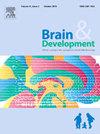营养不良男孩智力残疾及全智商与突变特征的基因型-表型相关性
IF 1.4
4区 医学
Q4 CLINICAL NEUROLOGY
引用次数: 0
摘要
背景:肌营养不良症患者的神经心理学评估表明,与一般人群相比,他们的平均全面智商(FSIQ)有所下降。然而,在印度次大陆尚未进行这方面的大规模纵向跟踪研究。方法采用Malin's Intelligence Scale for Indian children (MISIC),对6-16岁肌营养不良症儿童的语言、表现和FSIQ与年龄/社会经济地位匹配的健康对照进行前瞻性比较。此外,在研究期间完成至少一年随访的肌营养不良男孩中重复进行认知评估。通过将肌营养不良组分为Dp427、Dp140和Dp71亚型,探讨了FSIQ与突变特征之间的基因型-表型相关性。此外,我们还探讨了肌营养不良症患者认知状态的其他临床/遗传预测因素。结果肌营养不良组和对照组分别入组154例和77例。与对照组相比,肌营养不良组在言语、表现、FSIQ和所有子测试方面得分较低(p <;他们的表现智商(86.9±12.3 vs 83.6±11.4,p = 0.008)反而优于言语智商(p = 0.008)。Dp71组的语言、表现和FSIQ明显较低,在多变量分析中发现该亚型是肌营养不良症组智力残疾的独立预测因子。1年后的随访IQ评估(n = 47)显示FSIQ无显著降低(85.1±10.7 vs 84.3±11.2,p = 0.64)。结论肌营养不良男孩的智商低于健康对照组,Dp71亚型的认知障碍程度更明显。本文章由计算机程序翻译,如有差异,请以英文原文为准。
Intellectual disability and genotype-phenotype correlation between full-scale intelligence quotient and mutation characteristics in boys with dystrophinopathy
Background
Neuropsychological evaluations of dystrophinopathy patients indicate a decrease in mean full-scale intelligence quotient (FSIQ) compared to the general population. However, large-scale studies with longitudinal follow-up in this regard are yet to be conducted in the Indian subcontinent.
Methods
Verbal, performance, and FSIQ of children with dystrophinopathy, aged 6–16 years were prospectively compared with age/socioeconomic status matched healthy controls, using the Malin's Intelligence Scale for Indian children (MISIC). Additionally, cognitive assessments were repeated in dystrophinopathy boys who completed at least one year of follow-up during study period. Genotype-phenotype correlation was also explored between FSIQ and mutational characteristics by dividing the dystrophinopathy group into Dp427, Dp140, and Dp71 isoforms. Furthermore, other clinical/genetic predictors of cognitive status were explored in dystrophinopathy cases.
Results
A total of 154 and 77 boys were enrolled in the dystrophinopathy and control groups, respectively. While the dystrophinopathy group had lower scores in verbal, performance, FSIQ, and all sub-tests compared to the control group (p < 0.001), their performance IQ was paradoxically better than verbal IQ (86.9 ± 12.3 vs 83.6 ± 11.4, p = 0.008). The Dp71 group had significantly lower verbal, performance, and FSIQ, and this isoform was found to be an independent predictor of intellectual disability in the dystrophinopathy group in multivariate analysis. Follow-up IQ assessment after one year (n = 47) showed a non-significant reduction in FSIQ (85.1 ± 10.7 vs 84.3 ± 11.2, p = 0.64).
Conclusion
Boys with dystrophinopathy exhibit lower IQ compared to healthy controls, and the degree of cognitive impairment is more pronounced in cases with the Dp71 isoform.
求助全文
通过发布文献求助,成功后即可免费获取论文全文。
去求助
来源期刊

Brain & Development
医学-临床神经学
CiteScore
3.60
自引率
0.00%
发文量
153
审稿时长
50 days
期刊介绍:
Brain and Development (ISSN 0387-7604) is the Official Journal of the Japanese Society of Child Neurology, and is aimed to promote clinical child neurology and developmental neuroscience.
The journal is devoted to publishing Review Articles, Full Length Original Papers, Case Reports and Letters to the Editor in the field of Child Neurology and related sciences. Proceedings of meetings, and professional announcements will be published at the Editor''s discretion. Letters concerning articles published in Brain and Development and other relevant issues are also welcome.
 求助内容:
求助内容: 应助结果提醒方式:
应助结果提醒方式:


